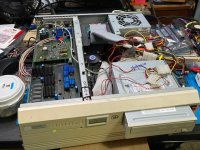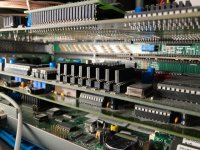I've been working on/off on this for about 10 years. Sometimes it is 2 steps forward, 3 steps back. Sometimes it say dormant for a while. A labor of love.
This is a Commodore Amiga 4000 using a GVP T-REX-II processor card with a 50MHz 68060 & 128MB RAM. There's an additional 256MB of RAM on a ZORRO-III expansion card and 18MB on the motherboard. For video editing, I'm using hardware from MacroSystem: VLab-Motion capture/playback card and Toccata 16bit 48KHz stereo audio card. The display card is a MacroSystem Retina BLT Z3 24bit card capable of up to 2400x1200, I'm running it with 1024x768 screens. My media drives are two CF cards in a Microtech dual-PCMCIA SCSI drive on the T-REX-II SCSI-II bus. T-REX-II SCSI-II is capable of up to 30MB/sec but the Microtech drive isn't that fast and the VLab-Motion card doesn't need it to be anyway. There's a chinon HD floppy drive in the 2nd 3-1/2" bay and a DVD-RW in the 5-1/4" bay.
This system can record/edit/playback full SD resolution NTSC or PAL at full 30fps/25fps frame rates. You can have up to 99 layers of audio/video in the editing software. Layered video and transitions require rendering, but straight cuts and rendered or unaltered video will playback in realtime. It has composite, s-video, and component video options.
I'm planning on making some videos demonstrating the use of MovieShop (the editing software) on this set-up. So far, I've done two basic videos showing some of it.
Audio testing:
Importing & organizing images:
Jaeson
This is a Commodore Amiga 4000 using a GVP T-REX-II processor card with a 50MHz 68060 & 128MB RAM. There's an additional 256MB of RAM on a ZORRO-III expansion card and 18MB on the motherboard. For video editing, I'm using hardware from MacroSystem: VLab-Motion capture/playback card and Toccata 16bit 48KHz stereo audio card. The display card is a MacroSystem Retina BLT Z3 24bit card capable of up to 2400x1200, I'm running it with 1024x768 screens. My media drives are two CF cards in a Microtech dual-PCMCIA SCSI drive on the T-REX-II SCSI-II bus. T-REX-II SCSI-II is capable of up to 30MB/sec but the Microtech drive isn't that fast and the VLab-Motion card doesn't need it to be anyway. There's a chinon HD floppy drive in the 2nd 3-1/2" bay and a DVD-RW in the 5-1/4" bay.
This system can record/edit/playback full SD resolution NTSC or PAL at full 30fps/25fps frame rates. You can have up to 99 layers of audio/video in the editing software. Layered video and transitions require rendering, but straight cuts and rendered or unaltered video will playback in realtime. It has composite, s-video, and component video options.
I'm planning on making some videos demonstrating the use of MovieShop (the editing software) on this set-up. So far, I've done two basic videos showing some of it.
Audio testing:
Jaeson


